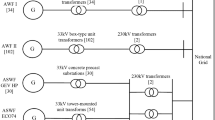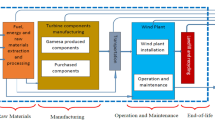Abstract
Purpose
The purpose of this project was to provide a parameterized LCA tool that allows performing site specific life cycle assessments for different wind energy converter types by varying a limited number of relevant parameters. Hereby, it addresses the limited transferability of WEC LCA results to other sites as well as the increasing demand for such data.
Methods
Basis of the work was an extensive primary data collection at the respective production facilities and other relevant stakeholders like site assessment, service etc. Most of the required data was available at first hand and was completed with data from literature and LCA databases. Based on this data, a complex parameterized material flow model has been built and different product variants have been pre-defined within the model, including relevant production processes and upstream. The pre-definition of these product variants allows reducing the minimum number of parameters that need to be configured for site specific LCAs from a total of over 330 to just nine parameters.
Results and conclusions
In the future, choosing the right type of technology for specific sites will become more important; especially in the face of increasing land use conflicts and increasing competition between renewable energy technologies. Site and technology specific LCAs prove to be a valuable tool for this assessment. Tools like the presented significantly reduce the effort required for performing these LCAs. Additionally, they can be used for various other purposes like environmental assessments of different repowering scenarios and eco design.









Similar content being viewed by others
References
Angerer G, Erdmann L, Marscheider-Weidemann F, Scharp M, Lüllmann A, Handke V, Marwede M (2009) Rohstoffe für Zukunftstechnologien. Einfluss des branchenspezifischen Rohstoffbedarfs in rohstoffintensiven Zukunftstechnologien auf die zukünftige Rohstoffnachfrage. Fraunhofer-IRB-Verl, Stuttgart
Briem S, Viebahn P, Gürzenich D, Corradini R et al (2004) Lebenszyklusanalyse ausgewählter zukünftiger Stromerzeugungstechniken. Forschungsvorhaben mit finanzieller Unterstützung des Bundesministeriums für Wirtschaft und Arbeit, Stuttgart
Buchert M, Schüler D, Bleher D (2009) Critical metals for future sustainable technologies and their recycling potential. Darmstadt
Bunk O (2002) A positive environmental balance. Converters amortize within a few month. Windblatt (3):12–13
BWE wy (2010) Energiebilanzen von Windenergie-Anlagen. http://www.wind-energie.de/de/themen/windenergie-von-a-z/energiebilanz/. Accessed 04 Aug 2010
Crawford RH (2007) Life-cycle energy analysis of wind turbines. an assessment of the effect of size on energy yield. WIT Transactions on Ecology and the Environment. doi:10.2495/ESUS070161
d’Souza N, Gbegbaje-Das E, Shonfield P (2011) Life cycle assessment of electricity production from a V112 turbine wind plant. Copenhagen
Elsam Engineering A/S (2004) Life cycle assessment of offshore and onshore sited wind farms, o.O. Available from: http://www.vestas.com/Admin/Public/DWSDownload.aspx?File=%2FFiles%2FFiler%2FEN%2FSustainability%2FLCA%2FLCA_V80_2004_uk.pdf [17 August 2010].
ENERCON GmbH (2011) ENERCON WECs produce clean energy without neodymium. http://www.enercon.de/en-en/1337.htm. Accessed 10 Dec 2011
Geuder M (2004) Energetische Bewertung von WEA. Was man über Stoff- und Energiebilanz von erneuerbaren Energien wissen muss. Erneuerbare Energien 8:25–29
Guezuraga B, Zauner R, Pölz W (2011) Life cycle assessment of two different 2MW class wind turbines. Renew Energ 37(1):37–44
JRC—Joint Research Center—Institute for Prospective Technological Studies (2010) Reference Documents. http://eippcb.jrc.es/reference/. Accessed 05 September 2011
Martínez E, Sanz F, Pellegrini S, Jiménez E, Blanco J (2009) Life cycle assessment of a multi-megawatt wind turbine. Renew Energ 34(3):667–673
Mayer-Spohn O, Wissel S, Voß A, Fahl U, Blesl M (2005) Lebenszyklusanalyse ausgewählter Stromerzeugungstechniken. Arbeitsbericht, Stuttgart
PE, LBP (1999–2008) GaBi 4. Software-System and Databases for Life Cycle Engineering, Stuttgart, Echterdingen
Pick E, Wagner H (1998) Beitrag zum kumulierten Energieaufwand ausgewählter Windenergiekonverter. Arbeitsbericht, Essen
Quaschning V (1999) Energetische Amortisation und Erntefaktoren regenerativer Energien, Berlin
Schleisner L (2000) Life cycle assessment of a wind farm and related externalities. Renew Energ 20:279–288
Tremeac B, Meunier F (2009) Life cycle analysis of 4.5MW and 250W wind turbines. Renew Sust Energ Rev 13(8):2104–2110
VAR Verband der Aluminumrecycling-Industrie e.V. (2010) Aluminium-Recycling. http://www.aluminium-recycling.com/de/recycling/allgemein.php. Accessed 15 Sep 2010
Vestas Wind Systems A/S (2006) Life cycle assessment of offshore and onshore sited wind power plants based on Vestas V90-3.0 MW turbines, 2nd edn. Randers, Denmark
vkn (2010) SAAR—Gesellschaft für die Verwertung von Kraftwerksnebenprodukten und Ersatzbrennstoffen Kesselsand. http://www.vkn-online.de/vkn_smartm/html/f/19/prod_strahl.html. Accessed 23 Sep 2010
Wagner H (2004) Ganzheitliche Energiebilanz von Windkraftanlagen: Wie sauber sind die weißen Riesen? maschinenbau RUBIN:6–11
Wagner H, Epe A (2009) Energy from wind—perspectives and research needs. Eur Phys J Spec Top 176(1):107–114
Worldsteel Association (2008) Worldsteel Recycling Methodology. Application of the worldsteel LCI data to recycling
Zimmermann T (2011) Entwicklung eines Life Cycle Assessment Tools für Windenergieanlagen. Thesis, Universität Bremen
Zimmermann T (2011) Fully parameterized LCA tool for wind energy converters. www.lcm2011.org/papers.html?file=tl_files/pdf/poster/day2/Zimmermann-Fully_parameterized_LCA_tool_for_wind_energy_converters-567_b.pdf [25 November 2011]
Zimmermann T, Gößling-Reisemann S (2011) Optimal repowering of wind energy converters: Energy demand and CO2 intensity as indicators. www.lcm2011.org/papers.html?file=tl_files/pdf/poster/day2/Zimmermann-Optimal_repowering_of_wind_energy_converters-601_b.pdf [25 November 2011]
Author information
Authors and Affiliations
Corresponding author
Additional information
Responsible editor: Berlan Rodriguez Perez
Rights and permissions
About this article
Cite this article
Zimmermann, T. Parameterized tool for site specific LCAs of wind energy converters. Int J Life Cycle Assess 18, 49–60 (2013). https://doi.org/10.1007/s11367-012-0467-y
Received:
Accepted:
Published:
Issue Date:
DOI: https://doi.org/10.1007/s11367-012-0467-y




